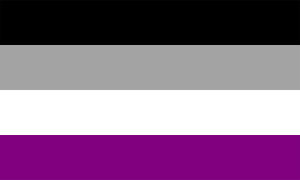Asexual Feminism, Feminist Asexuality
Happy Asexual Awareness Week, to those reading this on or before Sunday, October 25th!
Asexuality is a sexual orientation defined by the absence of sexual attraction to others… but you likely already know that, and if you don’t, I refer you to the resources list below. For this article I’d like to go a step or two beyond the basics, and [in]Visible Magazine seems an appropriate platform for this; after all, the most comprehensive book on asexuality labels it The Invisible Orientation (Decker 2014). So, how does asexuality fit into a broader intersectional feminist framework? Specifically, what can asexuality do for feminism, and what can feminism do for asexuality in return?
The answer to the first question is “quite a lot”! The growing prominence of ace-spectrum identities has refined many activists’ approach to teaching sex-positivity: just as critical as the freedom to be sexual and to reclaim the word “slut” is the freedom to say “No thanks, that’s not for me… but here’s what is.” Sexual liberation is not unidimensional; it must be founded in personal agency.
Asexuality likewise introduces nuance into discussions of consent: when Elisa Hansen, a minor Internet celebrity and openly asexual woman, received a concerned Tumblr ask regarding the implications of her marriage and pregnancy, her response included the crucial point that “sexual attraction/orientation is not necessarily the only reason why one might engage in sex acts. It’s true I’ve never given ‘enthusiastic consent’ to sex, but I have given loving, content, peaceful consent.” This reinforces two major feminist talking points: behavior does not determine orientation, and consent is not a one-size-fits-all proposition.
In addition to critiquing some of the language that has become engrained in feminist discourse, the online asexual community has developed a wealth of useful terminology that is beginning to see mainstream recognition. For every heterosexual who welcomes the term “panromantic,” one more bisexual finds “homoromantic” or even “aromantic” to be a good shorthand for their attraction experiences. Even sillier, non-academic contributions like “squish” (a nonsexual, nonromantic crush) and “zucchini” (a platonic partner) articulate concepts that, thanks in part to feminism, have become more open to discussion.
Regarding intersectionality, the asexual community has its own roadblocks to overcome, including policing of disability and neurodiversity; complicity in establishing an overwhelmingly white and privileged public image for purposes of credibility (the “unassailable asexual”); and reluctance to acknowledge existing cultural forces of desexualization and hypersexualization that complicate asexual identification for many people.
However, as we continue to learn from these faults and oversights, we lead in other areas. Intercommunity surveys have long found trans, nonbinary, and genderqueer individuals to be overrepresented in ace spaces relative to the general population, while male-identifiying individuals are underrepresented. Perhaps as a consequence, the asexual community is both highly supportive of gender self-determination and non-conformity and vocal in its advocacy for men, in a reflection of intersectional feminism’s own efforts to branch out into true gender equality. The various explanations proposed for the shortage of ace men in the online community touch on familiar themes: masculinity’s discouragement of any exploration of feelings, societal pressure to be highly sexual, and the condemnation of any deviation from strict heterosexuality. Evidently, asexual activism and intersectional feminism overlap in many of their concerns, objectives, and modes of outreach and education.
With all of that said… what can feminism do for asexuality? The obvious answer is “listen and acknowledge”; the more general answer is “help combat the invisibility.” Our community may not face institutional discrimination on par with many other sexual and gender identities (though acephobia can certainly lead to violence), but we do face frequent erasure, dismissal, shaming, mockery, and pathologization. Simple, mindful choices, like including asexuality in general lists of non-straight identities, acknowledging different alignments of sexual and romantic orientations, and rejecting the conflation of sexual attraction or desire with human nature, do not go unnoticed or unnappreciated by people on the asexual spectrum.
For allies who wish to engage more actively with the asexual community, the standard rules and encouragements apply: trust people on their experiences, seek out and distribute credible information and compelling resources, engage with the community’s more public figures, and support the smaller content producers in their search for a wider audience.
Feminism has never been a totally streamlined movement, but those of us riding its current wave have turned that to our advantage, using intersectionality as an essential framework for social progress. Asexual activism offers as much as it owes to feminist discourse, and the latter ideology can only be strengthened by recognizing asexuality as a valid, affirming identity.
Resources:
I’ve linked to a number of resources within the text of the article, but here are some additional online sources of information you may find helpful.
- AVEN – the largest online forum for discussion of all things related to asexuality
- Asexuality Archive – essays offering “a comprehensive and uncensored look” at asexual life
- What is Asexuality? – educational resources in various formats, directed at audiences such as teens, parents, and educators
- Asexual Awareness Week – official website for the annual initiative
- A common misconception is that AVEN remains the hub of the online asexual community, but this distinction really belongs to Ace Tumblr. Some popular bloggers are swankivy, redbeardace, queerascat, nextstepcake, ace-muslim, queenieofaces, and theasexualityblog, but there are many, many more!

![[in]Visible Magazine](https://community.scrippscollege.edu/invisible/wp-content/uploads/sites/5/2011/04/Invisible-Masthead-2011-Spring1.png)








Comments are closed.